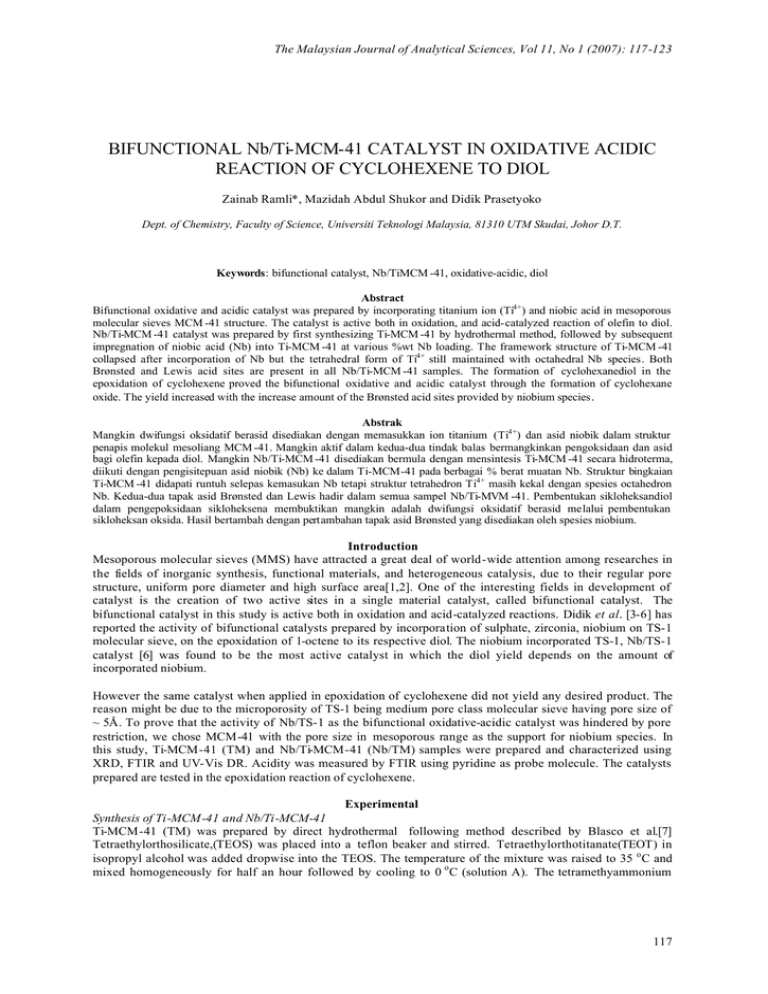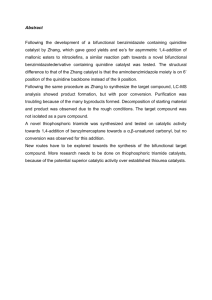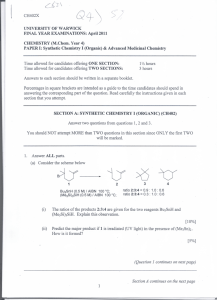BIFUNCTIONAL Nb/Ti-MCM-41 CATALYST IN OXIDATIVE ACIDIC REACTION OF CYCLOHEXENE TO DIOL
advertisement

The Malaysian Journal of Analytical Sciences, Vol 11, No 1 (2007): 117-123 BIFUNCTIONAL Nb/Ti-MCM-41 CATALYST IN OXIDATIVE ACIDIC REACTION OF CYCLOHEXENE TO DIOL Zainab Ramli*, Mazidah Abdul Shukor and Didik Prasetyoko Dept. of Chemistry, Faculty of Science, Universiti Teknologi Malaysia, 81310 UTM Skudai, Johor D.T. Keywords: bifunctional catalyst, Nb/TiMCM -41, oxidative-acidic, diol Abstract Bifunctional oxidative and acidic catalyst was prepared by incorporating titanium ion (Ti4+) and niobic acid in mesoporous molecular sieves MCM -41 structure. The catalyst is active both in oxidation, and acid-catalyzed reaction of olefin to diol. Nb/Ti-MCM -41 catalyst was prepared by first synthesizing Ti-MCM -41 by hydrothermal method, followed by subsequent impregnation of niobic acid (Nb) into Ti-MCM -41 at various %wt Nb loading. The framework structure of Ti-MCM -41 collapsed after incorporation of Nb but the tetrahedral form of Ti4+ still maintained with octahedral Nb species. Both Brønsted and Lewis acid sites are present in all Nb/Ti-MCM -41 samples. The formation of cyclohexanediol in the epoxidation of cyclohexene proved the bifunctional oxidative and acidic catalyst through the formation of cyclohexane oxide. The yield increased with the increase amount of the Brønsted acid sites provided by niobium species . Abstrak Mangkin dwifungsi oksidatif berasid disediakan dengan memasukkan ion titanium (Ti4+) dan asid niobik dalam struktur penapis molekul mesoliang MCM -41. Mangkin aktif dalam kedua-dua tindak balas bermangkinkan pengoksidaan dan asid bagi olefin kepada diol. Mangkin Nb/Ti-MCM -41 disediakan bermula dengan mensintesis Ti-MCM -41 secara hidroterma, diikuti dengan pengisitepuan asid niobik (Nb) ke dalam Ti-MCM-41 pada berbagai % berat muatan Nb. Struktur bingkaian Ti-MCM -41 didapati runtuh selepas kemasukan Nb tetapi struktur tetrahedron Ti4+ masih kekal dengan spesies octahedron Nb. Kedua-dua tapak asid Brønsted dan Lewis hadir dalam semua sampel Nb/Ti-MVM -41. Pembentukan sikloheksandiol dalam pengepoksidaan sikloheksena membuktikan mangkin adalah dwifungsi oksidatif berasid melalui pembentukan sikloheksan oksida. Hasil bertambah dengan pertambahan tapak asid Brønsted yang disediakan oleh spesies niobium. Introduction Mesoporous molecular sieves (MMS) have attracted a great deal of world-wide attention among researches in the fields of inorganic synthesis, functional materials, and heterogeneous catalysis, due to their regular pore structure, uniform pore diameter and high surface area[1,2]. One of the interesting fields in development of catalyst is the creation of two active sites in a single material catalyst, called bifunctional catalyst. The bifunctional catalyst in this study is active both in oxidation and acid-catalyzed reactions. Didik et al. [3-6] has reported the activity of bifunctional catalysts prepared by incorporation of sulphate, zirconia, niobium on TS-1 molecular sieve, on the epoxidation of 1-octene to its respective diol. The niobium incorporated TS-1, Nb/TS-1 catalyst [6] was found to be the most active catalyst in which the diol yield depends on the amount of incorporated niobium. However the same catalyst when applied in epoxidation of cyclohexene did not yield any desired product. The reason might be due to the microporosity of TS-1 being medium pore class molecular sieve having pore size of ~ 5Å. To prove that the activity of Nb/TS-1 as the bifunctional oxidative-acidic catalyst was hindered by pore restriction, we chose MCM-41 with the pore size in mesoporous range as the support for niobium species. In this study, Ti-MCM-41 (TM) and Nb/Ti-MCM-41 (Nb/TM) samples were prepared and characterized using XRD, FTIR and UV-Vis DR. Acidity was measured by FTIR using pyridine as probe molecule. The catalysts prepared are tested in the epoxidation reaction of cyclohexene. Experimental Synthesis of Ti-MCM-41 and Nb/Ti-MCM-41 Ti-MCM-41 (TM) was prepared by direct hydrothermal following method described by Blasco et al.[7] Tetraethylorthosilicate,(TEOS) was placed into a teflon beaker and stirred. Tetraethylorthotitanate(TEOT) in isopropyl alcohol was added dropwise into the TEOS. The temperature of the mixture was raised to 35 o C and mixed homogeneously for half an hour followed by cooling to 0 o C (solution A). The tetramethyammonium 117 Zainab Ramli et al.: BIFUNCTIONAL Nb/Ti-MCM -41 CATALYST IN OXIDATIVE ACIDIC hydroxide (TMAOH) was dissolved in water, followed by the addition of cetyltrimethylammonium bromide (CTMABr). The mixture was stirred for half an hour and then was also cooled to 0 o C (solution B). Solution B was added slowly to the solution A with stirring at 0 o C. The resulting gel with the oxide ratio 0.03Ti:1Si: 63.81H2 O: 0.39TMAOH: 1.02CTMABr was heated between 80 – 90 o C for 4 hours. Water was added and the gel was placed into PTFE bottle and heated at 98 o C in oven for 3 days. The solid was filtered and washed using hot water until the filtrate becomes neutral. Finally, the solid obtained was dried at 110o C overnight and calcined at 500 °C. Sample Nb/Ti-MCM -41 (Nb/TM) was prepared by impregnation technique using Nb(OC2 H5 )5 as Nb precursor. Dried TM and calculated amount of Nb(OC2 H5 )5 was mixed in n-hexane. The mixture was stirred for 3 hrs. The solid was recovered by evaporating the n-hexane at 80 o C followed by addition of HNO3 in distilled water and aged overnight. Finally, the solid was heated at 120o C until dried. Characterizations and Acidity Measurement Characterization by XRD for identification of the crystalline phases of the samples was done using a Bruker Advance D8 Difractometer with the Cu K? (? = 1.5405 Å) scanned in the 2? range of 1.5 – 12o at a step time 1 sec. The IR spectra of samples were collected on a Perkin Elmer FTIR using KBr pellet method. The framework spectra were recorded in the region of 1500-400 cm−1 . The geometry structure of Ti and Nb species in the samples were monitored by UV-Vis Diffuse Reflectance, recorded at ambient conditions on a Perkin Elmer Lambda 900 UV/VIS/NIR spectrometer in the wavenumber range 190-600 nm. For acidity study, the sample was made a 13mm disc. The sample was first heated at 400o C in vacuum conditions overnight. Before pyridine adsorption, the IR of the dehydrated samples was taken. Pyridine was then adsorbed for 5 seconds, continued by desorption at 150 o C for an hour. The IR spectra of the samples were taken at room temperature. Catalytic testing The catalysts performance was tested in the epoxidation of the cyclohexene using hydrogen peroxide as oxidant. The reaction mixture containing cyclohexene (10 mmol), H2 O2 (10 mmol) in acetonitrile (10 g) and cyclohexene (1.0 mmol) were placed in a 25 cm3 round bottom flask equipped with a magnetic stirrer and condenser. An amount of 0.05 g catalyst was added into the solution. The reaction was carried out in oil bath at 70 o C with continuous stirring. The aliquots were sampled out at regular time intervals and analyzed with GCFID using Ultra 1 methyl siloxane capillary column (25 m length, 0.25 mm diameters with 0.2 µm wall thickness). Results and Discussion Characterization of the catalysts The phase crystallinity of the samples is characterized by XRD. The diffractograms of Ti-MCM-41 (TM) and niobium incorporated TM samples (Nb/TM) are presented in Figure 1. The XRD of Ti-MCM -41 (TM) shows 3 diffraction lines with different intensities. The most intense peak relative to the (100) plane is usually taken as a measure for the crystallinity [4] or the highly ordered of the synthesized TM. Thus the intense d 100 peak indicates that the Ti-MCM-41 is highly ordered mesoporous material. However the peak was very much reduced in intensity and shifted to higher 2? upon incorporation of Nb on TM. The XRD patterns of Nb/TM samples does not shows any significant diffraction line, indicating that after impregnation of Nb species on TM, the MCM-41 framework structure has collapsed. 118 The Malaysian Journal of Analytical Sciences, Vol 11, No 1 (2007): 117-123 (100) Intensity/, a.u. Ti-MCM -41 1.5 3 4 5 6 7 8 9 10 6Nb/TM 3Nb/TM 1Nb/TM 1.5 3 5 7 9 11 2?, degree Figure 1: XRD of TM and Nb/TM samples at 1,3 and 6 %wt Nb loading (a) (b) Figure 2: FESEM micrographs of samples (a) TM and –magnification 50,000x (b) Nb/TM-magnification 30,000x Field Emission SEM (FESEM) was applied to study the surface morphology of the samples. FESEM micrographs of TM and Nb/TM sample are shown in Figure 2. “Worm” type of morphology and irregular shape particle was observed from the TM and Nb/TM samples. The sample after impregnation (Nb/TM) showed that the worm type has coagulated and agglomerated thus, the particles became larger. IR cannot ascertain the presence of framework Ti in the TM sample as the band assign for TiO4 at ca. 970 cm-1 [8] overlapping with Si-O band of silanol group which usually present in MCM-41 sample. However its present can be confirmed by UV-Vis DR. UV-Vis DR spectra of TM sample are shown in Figure 3. It exhibits a single 119 Zainab Ramli et al.: BIFUNCTIONAL Nb/Ti-MCM -41 CATALYST IN OXIDATIVE ACIDIC sharp absorption band at 226 nm, assigned to the ligand to metal charge transfer involving isolated titanium atom in the tetrahedral coordination [9]. For Nb/TM samples, a band appears at 226 nm-236 nm showing that the samples have retained the tetrahedral form of Ti. This is important to maintain the oxidative sites in the Nb/TM catalyst which only active when Ti4+.is in the form of tetrahedral. A shoulder band around 260 nm in Nb/TM samples is assigned to the octahedral Nb species [7]. The intensity of this band increased as the niobium content in the samples increased . 2.95 226 290 Niobic acid TM 2.5 6Nb/TM 3Nb/TM Intensity, K-M 2.0 1Nb/TM 1.5 1.0 0.5 0.0 190 300 400 Wavelength, nm 500 60 0 Figure 3: UV-Vis DR spectra of TM and Nb/TM samples Acidity Study Surface acidity of the samples was carried by pyridine adsorption at room temperature on the dehydrated samples at 400 o C under vacuum and monitored by IR spectroscopy. The type and the amount of the acid sites can be determined using this method. The IR spectra of the TM and Nb/TM samples after evacuation at 400o C show a single peak at ca. 3740 cm-1 in the hydroxyl region with quite high intensity. This peak is assigned for terminal silanol groups. The presence of silanol groups is a characteristic of MCM-41 sample. IR spectra in the pyridine region of the samples after pyridine adsorption and desorption at 150 °C are shown in Figure 4. All samples showed peaks at around 1545 cm-1 , 1490 cm-1 and 1447 cm-1 which were due to the Brønsted, Brønsted-Lewis mixture and Lewis sites, respectively. These results showed that Brønsted and Lewis acid sites are present in all samples. The amount of Brønsted acids increased with the increasing Nb loading on the TM. Table 1 listed the amount of Brønsted acid sites calculated on the basis of area under the peak at ca 1540 cm-1 . This finding indicates that Nb plays a role in the formation of Brønsted acid sites 120 The Malaysian Journal of Analytical Sciences, Vol 11, No 1 (2007): 117-123 Figure 4: IR spectra of the TM and Nb/TM samples in pyridine vibration region Catalytic activity Catalyst performance was investigated in the epoxidation of cyclohexene. Figure 5 shows the products of cyclohexene epoxidative-acidic reaction catalysed by the TM and Nb/TM samples while Table 1 listed the catalytic performance of the TM and Nb/TM samples in relation with the Brønsted acidity and the turn over frequency (TOF). All samples showed activity toward the formation of products, i.e. cyclohexane oxide, cyclohexenone, cyclohexenol and cyclohexanediol. However, in the absence of Nb, no cyclohexanediol was formed in the reaction catalyzed by TM sample while the amount of cyclohexanediol formed increased with the increase of Nb loading on Nb/TM samples. However, data from the turn over frequency (TOF) in Table 1 showed that sample 3Nb/TM gave higher value than sample 6Nb/TM while the sample 1Nb/TM gave the lowest TOF. It is suggested that the Brønsted acid sites in sample 3Nb/TM is more effective compared to other samples. This might be due to the presence of less polymerized niobium oxides species in sample 3Nb/TM as compared to sample 6Nb/TM as observed by UV-Vis DR spectroscopy. On the other hand, in term of selectivity of cyclohexanediol, high selectivity is observed on sample containing high amount of Brønsted acid sites i.e. sample 6Nb/TM. All TM containing Nb samples showed activity toward the formation of cyclohexanediol with sample 6Nb/TM gave higher yield of cyclohexanediol comp ared to samples 3Nb/TM and 1Nb/TM. The yield of cyclohexanediol increased due to the increase amount of Brønsted acid present in the catalysts as demonstrated by pyridine adsorption study. From the catalytic testing, it has been proven that the yield of cyclohexanediol increased when using the catalyst with high amount of Nb loading. Based on these findings it is suggested that the formation of cyclohexanediol is catalyzed by Brønsted acid sites 121 Zainab Ramli et al.: BIFUNCTIONAL Nb/Ti-MCM -41 CATALYST IN OXIDATIVE ACIDIC 9 cyclohexene cyclohexane oxide cyclohexenol cyclohexenone cyclohexanediol 8 7 products, mmol 6 5 4 3 2 1 0 0 1.31 3.52 6.46 Nb loading, wt% Figure 5: Histogram showing products from the epoxidative-acidic reaction of cyclohexene catalysed by TM and Nb/TM samples. Table 1: Catalytic activity of TM and Nb/TM samples Sample Conversion (%) Brønsted (µmolg -1 ) Diol (mmol) TOF (h -1 ) Selectivity (%) TM 2 1.39 - - - 1Nb/TM 5.2 4.46 1.27 271 29.66 3Nb/TM 3 6.52 5.19 758 49.76 6Nb/TM 3.2 11.09 8.25 708 57.53 Conclusion The bifunctional catalyst has successfully been synthesized in the Ti-M CM41 containing niobium. It was proven by characterizations, acidity measurement and catalytic testing on the epoxidation of cyclohexene. Acidity study has confirmed the presence of Brønsted and Lewis acid sites. The amount of Brønsted increased as the amount of niobium increased. The main product from the epoxidation reaction of cyclohexene by the catalysts is cyclohexanediol proved the bifunctional oxidative acidic function of the catalyst. The yield of cyclohexanediol increased with the increasing amount of Nb loading. Acknowledgement Authors would like to thank the Malaysian Ministry of Science, Technology and Innovation (MOSTI) for funding under IRPA project No. 09-02-06-0057 SR0005/09-03 References 1. 2. 122 Nowak, I. Ziolek, M. 2005. “Effect of Texture and Structure on the Catalytic Activity of Mesoporous Niobosilicates for the Oxidation of Cyclohexene”. Micropor. Mesopor. Mater. 78. 281-288. Nowak, I. Kilos, B. Ziolek, M. Lewandowska, A. 2003. “Epoxidation of Cyclohexenon Nb-containing Meso and Macroporous Maetrials”. Catal. Today. 78. 487-498. The Malaysian Journal of Analytical Sciences, Vol 11, No 1 (2007): 117-123 3. 4. 5. 6. 7. 8 9. Didik Prasetyoko, Salasiah Endud, Zainab Ramli and Hadi Nur 2005. “Enhancement of Catalytic Activity of Titanosilicalite-1 – Sulfated Zirconia Combination Towards Epoxidation of 1-Octene with Aqueous Hydrogen Peroxide”. Reaction Kinetics and Catalysis Letters. 86(1): 83-89, Hadi Nur, Didik Prasetyoko, Salasiah Endud, and Zainab Ramli. 2004. “Sulfation: a Simple Method to Enhance the Catalytic Activity of TS-1 in Epoxidation of 1-Octene with Aqueous Hydrogen Peroxide”. Catalysis Communications. 5: 725-728,. Didik Prasetyoko, Zainab Ramli, Salasiah Endud, and Hadi Nur. 2005. “Structural and Superacidity Study of Bifunctional Catalyst, Sulfated-Titanium/TS-1”. Malaysian Journal of Chemistry. 7(1): 011-018. D. Prasetyoko. Zainab Ramli. Salasiah Endud. H. Nur. 2005. “Preparation and Characterization of Bifunctional Oxidative and Acidic Catalysts Nb2O5/TS-1 for Synthesis of Diols”. Mater. Chem. Phys. 93. 443-449. Blasco, T. Corma, A. Navarro, M.T. Pèrez Pariente, J. 1995. “Synthesis, Characterization, and Catalytic Activity of TiMCM-41 Structures”. J. Catal. 156. 65-74. Zecchina, A. Bordiga, S. Spoto, Lamberti, C, Ricchiardi, G.., Scarano, D., Petrini, G. Leofanti, G. Mantegazza, M. 1996. Structural characterization of Ti centres in Ti-silicalite and reaction mechanism in cyclohexanone ammoximation. Catal Today. 32: 97-106 Yu, Jiangqiang. Feng, Zhaochi. Xu, Lei. Li, Meijun. Xin, Qin. Liu, Zhongmin. Li, Can. 2001. “Ti-MCM -41 Synthesized from Colloidal Silica and Titanium Trichloride: Synthesis, Characterization and Catalysis”. Chem. Mater. 13. 994-998. 123




